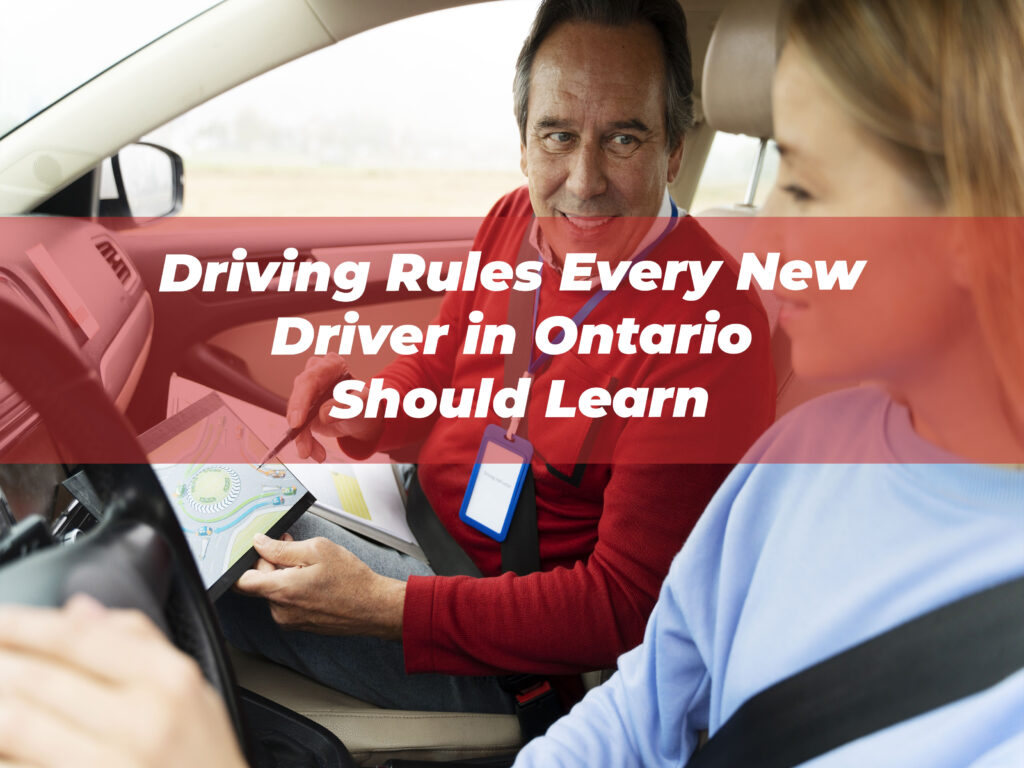Getting behind the wheel for the first time is both exciting and nerve-New Driver in Ontario. For new drivers in Ontario, understanding the essential driving rules isn’t just about passing the test—it’s about building confidence and staying safe on the road. Ontario has specific laws and regulations to ensure drivers develop the skills needed to share the road responsibly. From the graduated licensing system to critical road rules, this guide covers everything every new driver should know to hit the road with confidence.
Understanding Ontario’s Graduated New Driver in Ontario
Ontario’s graduated licensing system is designed to help new drivers gain experience in stages. It can take approximately 20 months to become a fully licensed driver, but the system ensures beginners are gradually exposed to more complex driving situations.
Step 1: The G1 License
The G1 license is the first step toward becoming a fully licensed driver in New Driver in Ontario. To get it, you’ll need to pass a written test that covers traffic signs, rules of the road, and safe driving practices. Here’s what you need to know about the G1 stage:
- Accompanied Driving Only: G1 drivers must always be accompanied by a fully licensed driver with at least four years of G experience. Your supervisor must sit in the front passenger seat.
- No Alcohol: G1 drivers must maintain a blood alcohol content (BAC) of zero while driving.
- Highway Restrictions: You can’t drive on 400-series highways or other roads with speeds over 80 km/h unless accompanied by a certified driving instructor.
- Nighttime Restrictions: Driving between midnight and 5 a.m. isn’t permitted.
Step 2: The G2 License
After holding your G1 license for at least 12 New Driver in Ontario, you’ll be eligible to take the G1 road test to advance to a G2 license. G2 drivers enjoy more freedom:
- Solo Driving Allowed: You can drive unsupervised, including on highways.
- Seatbelt Requirement: Every passenger must wear a seatbelt.
- Zero BAC Rule: Just like with a G1, you must not have alcohol in your system while driving.
However, if you’re under 20, you must limit the number of passengers aged 19 and under during the first six months of having a G2 (nighttime driving restrictions apply).
Step 3: The Full G License
The final step is earning your full G license by passing a New Driver in Ontario road test that assesses highway driving and advanced skills. Once you achieve this level, you’re a fully licensed driver in Ontario, with no restrictions beyond those applicable to all drivers.
Graduated licensing ensures drivers build their skills slowly and responsibly. Be patient, practice consistently, and you will get there.
Essential Road Rules for Ontario Drivers
Along with understanding the licensing process, new drivers must familiarize themselves with Ontario’s key road rules. Here are some basic driver responsibilities to keep in mind:
1. Obey Speed Limits
Speed limits ensure the safety of everyone on the New Driver in Ontario. Pay close attention to posted speed signs and adjust for driving conditions. For instance:
- Residential areas often have speed limits of 40–50 km/h.
- On highways, the speed limit is generally 100 km/h unless otherwise posted.
Driving too fast (or too slow) can lead to fines, license suspensions, or even accidents.
2. Understand Right-of-Way
Knowing when to yield helps prevent confusion and collisions. Some general Ontario right-of-way rules include:
- Yield to pedestrians at crosswalks or intersections.
- At four-way stops, the first driver to stop has the right-of-way. If two vehicles arrive simultaneously, the vehicle on the right proceeds first.
- When turning left, wait for oncoming traffic and pedestrians to clear before proceeding.
3. Avoid Distracted Driving
Distracted driving (e.g., texting, talking on the phone, or eating) is one of the New Driver in Ontario causes of traffic accidents. Ontario has strict penalties for distracted driving, including hefty fines and demerit points. Always focus on the road and use hands-free devices if necessary.
4. Follow Traffic Signals
Traffic lights and stop signs regulate traffic flow. Some important rules include:
- Red Light: Stop completely before the intersection. You can turn right on red unless prohibited by a sign.
- Flashing Green Light (Pedestrian-Controlled): Slow down and yield to pedestrians before proceeding.
Always remain cautious at intersections since they are hotspots for accidents.
5. Mind School Zones and Buses
When driving in school zones:
- Keep your speed below the New Driver in Ontario limit (usually 40 km/h).
- Be prepared to stop for crossing guards or children crossing the road.
For school buses displaying flashing red lights, drivers in both directions must stop at least 20 meters away until the lights stop flashing. Failing to do so can lead to harsh fines and penalties.
6. Learn About Lane Changes
Proper lane discipline ensures smooth traffic flow. When switching lanes:
- Always check your blind spots and use your signal.
- Avoid weaving between lanes, as it’s both unsafe and illegal.
Ontario roads also include High Occupancy Vehicle (HOV) lanes, reserved for vehicles with multiple passengers. Make sure you’re eligible before using these lanes.

Tips for Safe Driving
Becoming a safe and confident driver takes time and New Driver in Ontario. Here are some tips to help you along the way:
1. Practice Defensive Driving
Driving defensively means anticipating the actions of others and being prepared to avoid potential accidents. Key defensive driving practices include:
- Keeping a safe distance (at least two car lengths) from the vehicle in front of you.
- Scanning ahead for potential hazards, such as pedestrians or sudden stops.
- Avoiding aggressive drivers and road rage situations.
2. Adjust to Weather Conditions
Ontario is no stranger to harsh weather. Whether it’s heavy New Driver in Ontario, rain, or icy roads, always adapt your driving to the conditions. For example:
- Slow down and increase your following distance on slippery roads.
- Ensure your windshield wipers and defrosters are working before heading out.
- Use snow tires in winter for enhanced traction.
Safety comes first, no matter the weather.
3. Learn Parking Skills
Parallel parking and reversing into tight spaces can be challenging for beginners. Practice these maneuvers in empty parking lots or quieter areas to build confidence. When parking:
- Avoid blocking driveways, hydrants, or no-parking zones.
- Always use your handbrake on slopes to prevent the car from rolling.
If you’re under pressure to park in a tight spot, take your New Driver in Ontario. There’s no need to rush.
4. Stay Alert
Driving requires your full attention at all times. While driving, stay mentally focused and physically alert by:
- Taking regular breaks during long trips.
- Avoiding driving when drowsy, stressed, or distracted.
- Keeping two hands on the wheel in proper driving positions (e.g., 9 o’clock and 3 o’clock).
Common Mistakes New Drivers Make
New drivers often feel overwhelmed, leading to a few common mistakes. Avoiding these will help you become a more capable driver:
1. Failing to Signal
Forgetting to signal during lane changes or turns can New Driver in Ontario other drivers and lead to dangerous situations. Always use your turn signals in advance.
2. Tailgating
Following too closely behind another vehicle reduces your reaction time. Always keep a safe following distance.
3. Rolling Stops at Stop Signs
Coming to a complete stop shows you’re aware of the rules and gives you time to assess your surroundings. “Rolling stops” are illegal and often lead to accidents.
4. Overcorrecting During Turns
Sudden or aggressive steering corrections can make the car unstable. New Driver in Ontario smooth and gradual turns to stay in control.
5. Ignoring Blind Spots
Failing to check your blind spots when changing lanes is a dangerous mistake. Always check over your shoulder for nearby vehicles or cyclists.
Additional Resources for New Drivers
Ontario provides plenty of resources to help new drivers thrive:
- Driver’s Handbook: Ontario’s official New Driver in Ontario handbook contains all the rules of the road and tips for beginners.
- Driving Schools: Taking professional driving lessons can teach you advanced skills and may even help reduce your insurance premiums.
- Online Practice Tests: Many websites offer practice tests to help you ace the G1 written exam.
- Apps for Route Planning: GPS apps like Google Maps or Waze help new drivers plan routes and avoid confusing detours.
Wrapping Up
For new drivers in Ontario, understanding and following driving rules is more than just a requirement—it’s the foundation for safe and responsible driving. Build your skills gradually through the graduated licensing system, master New Driver in Ontario essential road rules, and practice safe driving techniques every time you hit the road.










